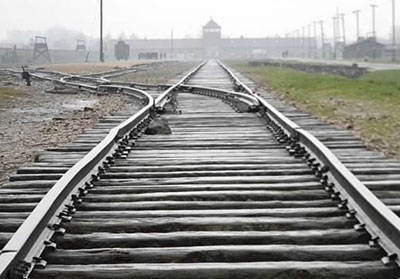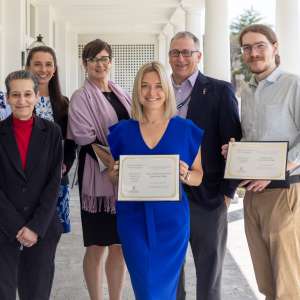The Power of Place: Auschwitz, 70 Years after Liberation

Cohen Center Education Coordinator White Talks about Trip to Poland
Tom White paused as he stood before the infamous “Arbeit Macht Frei” gate at the entrance of Auschwitz I, a World War II Nazi concentration camp located on the outskirts of the Polish industrial town of Oświęcim where at least 1.1 million prisoners, about 90 percent of them Jewish, were killed.
Taking a moment to collect his thoughts before embarking on the long- awaited walk past rows of barbaric barracks, several gas chambers, and crematoria that would leave a lasting impression on him, White, the coordinator of educational outreach for Keene State’s Cohen Center for Holocaust and Genocide Studies, was taken aback by the site of young teenage girls smiling and giggling while posing for pictures and taking selfies at the gate.
“It never bothered me when I saw kids in historic settings, laughing and having a good time,” said White, who had seen similar reactions at the United States Holocaust Memorial Museum in Washington, DC. “But here it bothered me for the first time. It devastated me that day.”
To White’s way of thinking, it was a violation of space. “People like to claim space for our own, but this isn’t our space,” he said. “Recognizing other people’s suffering allows you a space to mourn.”
It wouldn’t be the last time White would be overcome by the memory of the atrocities and dehumanizing deeds that took place inside these barb-wired walls.
White made his remarks while speaking at a recent presentation, “The Power of Place: Auschwitz, 70 Years after Liberation,” in Centennial Hall at the Alumni Center. Last fall, White visited Poland and Auschwitz with the Auschwitz Institute for Peace and Reconciliation (AIPR). His presentation, based on that visit, explored the challenges of encountering such a place, the impact of the camp on his approaches to teaching, what the camp reveals about the moral universe of the perpetrator, and what our possible responses to this should be.
Prior to the presentation, Dr. Henry Knight, director of the Cohen Center for Holocaust and Genocide Studies, gave a brief history of Auschwitz and introduced Kathy Preston of Barnstead, the only Holocaust survivor in attendance. At the age of five, she escaped the Nazi roundup of Jews in Hungary when a neighbor hid her in the attic. Preston, whose father was murdered in Auschwitz, lit a candle to honor the victims of the Holocaust.
White’s powerful presentation began in Kazimierz, the Jewish center of downtown Krakow, and took the audience on a mesmerizing tour of Auschwitz and its satellite camps through his experiences and photos. Throughout his talk, White frequently referenced the words “One can visit Auschwitz; one can never be in Auschwitz.” As a visitor to and a caretaker of the space, he also recalled the words of Auschwitz survivor Henry Appel, who lived through the horror and wrote that we have a duty to pursue redemption here: “There is one thing worse than Auschwitz itself … and that is if the world forgets that there was ever such a place.”
White was originally going to refrain from taking photos inside the camp, but had second thoughts. “I had this sense of going on sacred space that isn’t mine and using it for my own agenda, so I was very cautious and didn’t want to do this,” he said. “And then I thought, other people have to see this. We must do this so there is a witness.”
What White witnessed is at times beyond description. Often venturing out on his own, he walked around the perimeter of the camp as well as through its structures. He described in detail the buildings and cells and, finally, the gas chambers where so many lives were lost. White didn’t hide his distress, telling the audience that “the perpetrators systematically were inside a moral universe they created – they believed they were doing the decent and right thing,” he said. “And I want you to be outraged by that.”
Overcome by emotion and at times gasping for air, feeling as if the walls of the prison were closing in on him, White at times had to escape outside and find solace among friends. “Standing there, you try to wrap your mind around what happened there and you still can’t,” he said. “You don’t want to get that close. What happened wasn’t rational. It was physical. So as I went to the camp I just remembered my whole body contracting, my breath being taken from me. I began to shake. It was all subconscious because I couldn’t rationalize it.”
White said he learned a valuable lesson that day. “As a teacher, I tell my students we can never do anything in this world by ourselves,” he said. “We try to be rocks and make it by ourselves, but you’ll never survive. You need other people in this journey and yet here I was out there exploring on my own.”
White admits he had several sleepless night during and after his trip, not only coming to grips with what he saw and experienced, but figuring out the best way to convey the scope of what happened at Auschwitz to the people back home.
Sifting through his photos at home, White devised a way to tell his story. Preparing his power-point presentation, he began juxtaposing his photos of modern-day Auschwitz with those taken by the Nazis. “I began to interplay their images off of mine and they started to make sense to me in ways they never had before,” White told the audience.
The Nazis’ images of deception, taken in 1944, lined up with photos taken in the same locations over 70 years later, served as an eerie reminder that time doesn’t heal the wounds or the memories. Many of the photos left the audience gasping, including one that showed long lines of prisoners arriving on trains at the Gate of Death, surprisingly calm and sedate, unaware of the fate that lay ahead for them. By contrast, White’s photo of the same ramp is void of people except for a small metal marker depicting three humans at the end of the track.
Many images in the presentation defy description. The lens on White’s camera might bring the audience inside the camp, but it cannot convey the anguish of what happened there. Other photos left the audience perplexed. A simple photo showing canisters of shoe polish piled up on top of each other needed an explanation. As White suggested, “unaware of their destination, the Jews still wanted to look presentable.”
Photos connect the past with the present. The harsh reminder of what happened in Auschwitz is around every corner. During one of his solo excursions, White was overcome again, not by a building or symbol, but by a wall of life. In October 1986, Ann Weiss (who lost her family at the camp) entered a locked room at Auschwitz and came across an archive of over 2,400 photographs brought to the death camp by Jewish deportees from across Europe during the Holocaust. The photos, both candid snapshots and studied portraits, had been confiscated, but instead of being destroyed they were hidden at great risk and saved. In many cases these pictures are the only remnants left of entire families.
As his presentation drew to a close, White stressed the importance of keeping the memory of what happened in Auschwitz alive. He acknowledged that, with the commemoration of the 70th anniversary of its liberation, there will be fewer and fewer survivors to tell the story.
White also had the opportunity to travel to Israel and meet many Holocaust survivors. He recalled a poignant exchange between a trip colleague and a female survivor. He asked this woman, “How do you get back at them?” Prompted several times, the woman finally responded by saying, “I’ve got grandchildren. I chose life.”
Like White, Holocaust survivor Preston travels to schools, telling her story. “I think it’s very important to remind people about Auschwitz so it won’t happen again,” she said. “One of the things I tell the children when I talk: I say to them, ‘I don’t hate. It took me 50 years to stop hating. But every time I gave birth to a Jewish child it was like giving the finger to Hitler.’ And the kids love it.”





